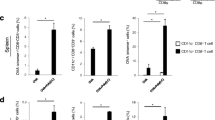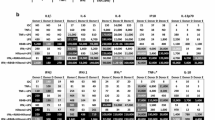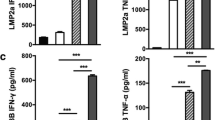Abstract
Background
Mature dendritics cells (DCs) are potent antigen-presenting cells that activate naive T lymphocytes and initiate cellular immune responses. The ability of CD83+ mature DCs infected with vaccinia virus encoding the gp 100 melanoma transgene (rV-gp 100) to stimulate an antimelanoma CD8+ T-cell response was investigated.
Methods
Monocyte-derived immature or CD83+ mature DCs were infected with rV-gp100. The activation state of the DCs and the expression of gp 100 protein were evaluated by flow cytometry. The reactivity of antimelanoma CD8+ T cells was confirmed by measuring specific interferon γ secretion by using enzyme-linked immunosorbent assay in a mixed-tumor lymphocyte culture.
Results
Both immature and CD83+ mature DCs expressed gp 100 protein when the DCs were infected with rV-gp 100. Calcium-signaling agents were required to induce maturation of both infected and nonifected immature DCs. Only rV-gp100-infected CD83+ DCs induced CD8+ T cells, after a single stimulation that recognized both peptide-pulsed target cells to multiple gp 100 epitopes and a melanoma cell line that endogenously expressed gp 100 antigen.
Conclusions
CD83+ DCs transduced with rV-gp 100 are capable of generating a strong CD8+ T-cell response against melanoma tumor cells. Expression of melanoma antigens by mature DCs offers the potential advantage of presenting multiple endogenously processed T-cells epitopes and using multiple HLA restriction elements for antimelanoma vaccine therapy.
Similar content being viewed by others
References
Steinman RM, Cohn ZA. Identification of a novel cell type in peripheral lymphoid organs of mice. I. Morphology, quantitation, tissue distribution.J Exp Med 1973;137:1142–62.
Steinman RM. The dendritic cell system and its role in immunogenicity.Annu Rev Immunol 1991;9:271–96.
Matzinger P. Tolerance, danger and the extended family.Annu Rev Immunol 1994;12:991–1045.
Paglia P, Chiodini C, Rodolfo M, Colombo MP. Murine dendritic cells loadedin vitro with soluble protein prime cytotoxic T lymphocytes against tumor antigenin vivo.J Exp Med 1996;183:317–22.
Grabbe S, Bruvers S, Gallo RL, Knisely R, Nazareno R, Granstein RD. Tumor antigen presentation by murine epidermal cells.J Immunol 1991;146:3656–66.
Porgador A, Gilboa E. Bone marrow-generated dendritic cells pulsed with a class I-restricted peptide are potent inducers of cytotoxic T lymphocytes.J Exp Med 1995;182:255–61.
Kugler A, Stuhler G, Walden P, et al. Regression of human metastatic renal cell carcinoma after vaccination with cell-dendritic cell hybrids.Nat Med 2000;6:332–6.
Ashley DM, Faiola B, Nair S, Bigner LP, Bigner DD, Gilboa E. Bone marrow-generated dendritic cells pulsed with tumor extracts or tumor RNA induce anti-tumor immunity against central nervous system tumors.J Exp Med 1997;186:1177–82.
Celluzzi CM, Mayordomo JI, Storkus WJ, Lotze MT, Falo LD Jr. Peptide-pulsed dendritic cells induce antigen-specific CTL-mediated protective tumor immunity.J Exp Med 1996;183:283–90.
Nestle FO, Alijagic S, Gilliet M, et al. Vaccination of melanoma patients with peptide- or tumor lysate-pulsed dendritic cells.Nat Med 1998;4:328–36.
Rosenberg SA, Yang JC, Schwartzentruber DJ, et al. Immunological and therapeutic evaluation of a synthetic peptide vaccine for the treatment of patients with metastatic melanoma.Nat Med 1998;4:321–7.
Hsu FJ, Benike C, Fagnoni F, et al. Vaccination of patients with B-cell lymphoma using autologous antigen-pulsed dendritic cells.Nat Med 1996;2:52–8.
Salgaller M, Tjoa B, Lodge P, et al. Dendritic cell-based immunotherapy of prostate cancer.Crit Rev Immunol 1998;18:109–19.
Morse M, Deng Y, Coleman D, et al. A phase I study of active immunotherapy with carcinoembryonic antigen peptide (CAP-1)-pulsed autologous human cultured dendritic cells in patients with metastatic malignancies expressing carcinoembryonic antigen.Clin Cancer Res 1999;5:1331–8.
Titzer S, Christensen O, Manzke O, et al. Vaccination of multiple myeloma patients with idiotype-pulsed dendritic cells: immunological and clinical aspects.Br J Haematol 2000;108:805–16.
Schuler-Thurner B, Dieckmann D, Keikavoussi P, et al. Mage-3 and influenza-matrix peptide-specific cytotoxic T cells are inducible in terminal stage HLA-A2.I+ melanoma patients by mature monocyte-derived dendritic cells.J Immunol 2000;165:3492–6.
Mackensen A, Herbst B, Chen J, et al. Phase I study in melanoma patients of a vaccine with peptide-pulsed dendritic cells generatedin vitro from CD34+ hematopoietic progenitor cells.Int J Cancer 2000;86:385–92.
Dhodapkar M, Steinman R, Krasousky J, Munz T, Bhardwai N. Antigen-specific inhibition of effector T cell function in humans after injection of immature dendritic cells.J Exp Med 2001;193:233–40.
Cella M, Scheidegger D, Palmer-Lehmann K, Lane P, Lanzavechia A, Alber G. Ligation of CD40 on dendritic cell triggers production of high levels of interleukin-12 and enhances T cell stimulatory capacity: T-T help via APC activation.J Exp Med 1996;184:747–52.
Sallusto F, Lanzavecchia A. Efficient presentations of soluble antigen by cultured human dendritic cells is maintained by granulocyte/macrophage colony-stimulating factor plus interleukin 4 and downregulated by tumor necrosis factor alpha.J Exp Med 1994; 179:1109–18.
Czerniecki B, Carter C, Rivoltini L, et al. Calcium ionophoretreated peripheral blood monocyte and dendritic cells rapidly display characteristics of activated dendritic cells.J Immunol 1997; 159:3823–37.
Bedrosan I, Roros JG, Xu S, et al. Granulocyte-macrophage colony stimulating factor, interleukin-2, and interleukin-12 synergize with calcium ionophore to enhance dendritic cell function.J Immunother 2000;23:311–20.
Engels F, Koski GK, Bedrosian I, et al. Calcium signaling induces the acquisition of dendritic cell characteristics in CML myeloid progentor cells.Proc Natl Acad Sci U S A 1999;96:10332–7.
Kim CJ, Cormier J, Roden M, et al. Use of recombinant poxviruses to stimulate anti-melanoma T cell reactivity.Ann Surg Oncol 1998;5:64–76.
Yang S, Kittlesen D, Slingluff CL, Vervaert CE, Seigler HF, Darrow TL. Dendritic cells infected with a vaccinia vector carrying the human gp 100 gene simultaneously present multiple specificities and elicit high-affinity T cells reactive to multiple epitopes and restricted by HLA-A2 and-A3J Immunol 2000;164:4204–11
Bhardwaj N, Bender A, Gonzalez N, Bui LK, Garrett MC, Steinman RN. Influenza virus-infected dendritic cell stimulate strong proliferative and cytolytic responses from human CD8+ T cells.J Clin Invest 1994;94:797–807.
Rosenberg SA, Zhai Y, Yang JC, et al. Immunizing patients with metastatic melanoma using recombinant adenoviruses encoding MART-1 or gp 100 melanoma antigens.J Natl Cancer Inst 1998; 90:1894–900.
Ribas A, Butterfield LH, McBride WH, et al. Genetic immunization for the melanoma antigen MART-1/Melan-A using recombinant adenovirus-transduced murine dendritic cells.Cancer Res 1997;57:2865–9.
Yang S, Vervaert C, Burch J, Grichnik J, Seigler FH, Darrow T. Murine dendritic cells transfected with human gp 100 elicit both antigen-specific CD8 and CD4 T-cell responses and are more effective than DNA vaccines at generating anti-tumor immunity.Int J Cancer 1999;83:532–44.
Overwijk W, Lee D, Surman D, et al. Vaccination with a recombinant vaccinia virus encoding a “self” antigen induces autoimmune vitiligo and tumor cell destriction in mice: requirement for CD4+ T lymphocytes.Proc Natl Acad Sci U S A 1999;96:2982–9.
Kaplan J, Yu Q, Piraino S, et al. Induction of anti-tumor immunity with dendritic cells transduced with adenovirus vector-encoding endogenous tumor-associated antigens.J Immunol 1999;163:699–705.
Mazzara G, Destree A, Mahr A. Generation and analysis of vaccinia virus recombinants.Methods Enzymol 1993;217:557–81.
Rivoltini L, Barracchini KC, Viggiano V, et al. Quantitative correlation between HLA class I allele expression and recognition of melanoma cells by antigen-specific cytotoxic T lymphocytes.Cancer Res 1995;55:3149–57.
Salter R, Howell D, Cresswell P Genes regulating HLA class I antigen expression in T-B lymphoblast hybrids.Immunogenetics 1985;21:235–42.
Parkhurst MR, Salgaller ML, Southwood S, et al. Improved induction of melanoma-reactive CTL with peptides from the melanoma antigen gp 100 modified at HLA-A*0201-binding residues.J Immunol 1991;157:2539–48.
Rivoltini L, Kawakami Y, Sakaguchi K, et al. Induction of tumorreactive CTL from peripheral blood and tumor-infiltrating lymphocytes of melanoma patients byin vitro stimulation with an immunodominant peptide of the human melanoma antigen MART-1J Immunol 1995;154:2257–65.
Germain RN, Margulies DH. The biochemistry and cell biology of antigen processing and presentation.Annu Rev Immunol 1993;11:403–10.
Faries MB, Bedrosian I, Xu S, et al. Calcium signaling inhibits IL-12 production and activates CD83+ dendritic cells that induce Th2 cell development.Blood 2001;98:2489–97.
Lyakh LA, Koshi GK, Young HA, Spence SE, Cohen PA, Rice NR. Adenovirus type 5 vectors induce dendritic cell differentiation in human CD14(+) monocytes cultured under serum-free conditions.Blood 2002;99:600–8.
Cohen PA, Peng L, Plautz GE, Kim JA, Weng DE, Shu S. CD4+ T cells in adoptive immunotherapy and the indirect mechanism of tumor rejection.Crit Rev Immunol 2000;20:17–56.
Czerniecki BJ, Cohen PA, Faries M, Xu S, Roros JG, Bedrosian I. Diverse functional activity of CD83+ monocyte-derived dendritic cells and the implications for cancer vaccines.Crit Rev Immunol 2001;21:157–78.
Author information
Authors and Affiliations
Corresponding author
Rights and permissions
About this article
Cite this article
Prabakaran, I., Menon, C., Xu, S. et al. Mature CD83+ dendritic cells infected with recombinant gp 100 vaccinia virus stimulate potent antimelanoma T cells. Annals of Surgical Oncology 9, 411–418 (2002). https://doi.org/10.1007/BF02573878
Received:
Accepted:
Issue Date:
DOI: https://doi.org/10.1007/BF02573878




